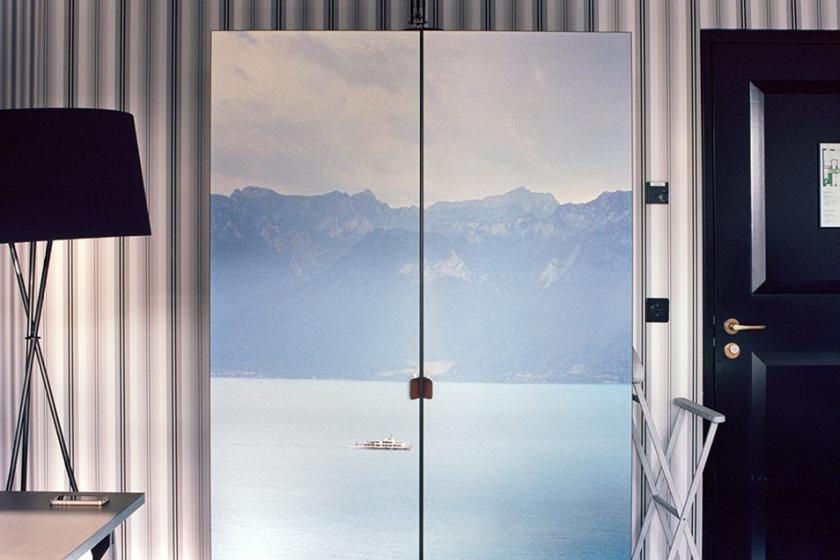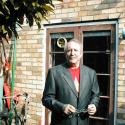As a photographer, Teju Cole has a penchant for the scuffed and distressed surfaces, materials and tools that form rectilinear patterns on construction sites. Opposite a shot of scaffolding, ladders and shadows – all favourite motifs – on the island of Bali, he writes a sort-of manifesto for the method of this book. “I do not love the travel pages,” he, somewhat superfluously, declares. Rather, he turns his lens (he uses manual cameras, which carry the old-fashioned risk of a ruined roll of film) on the margins, the edges, the corners, especially of urban life: “the substratum of the visible environment”. Take him to Venice and he will shoot not a canal or a palazzo, still less some trite iconic art-work, but the knock-off handbags sold by African street-vendors just chased away by the police. Yet “an intense attachment to the beautiful remains. The sun pours itself all over the world and the world’s things.
Across these 150-plus photographs, each partnered on the facing page by texts that serve as oblique captions, as mini-essays or as prose-poems (sometimes all three), he visits an enviably wide span of destinations. They stretch from his home in Brooklyn and other American places to Switzerland, Germany, Italy, Lebanon, Brazil, Jamaica, South Korea, Indonesia, the Republic of Congo and Nigeria. Born to Nigerian parents in the US, Cole grew up back in Lagos, studied in the US and London, and over the past decade has made an indelible, if somewhat enigmatic, mark as a writer of fiction, an essayist and – with this book – an artist in images as well.
In his fiction – Every Day is for the Thief and Open City – he wrote as a sort of flâneur, drifting through the globalised metropolis. The keen eyes and offbeat angles of his Romantic and Modernist forerunners were sharpened by his African migrant’s vision of cultural bridges, and barriers. As an art historian, Cole also packed his urban pilgrimages with a sensitive awareness of signs, traces and textures as the fragmentary evidence of history. Reading Cole, and looking at his word-enhanced images of rubble, fences, floors, walls, placards, sourced from Berlin or São Paulo, Beirut or Seoul, we understand that they tell a multitude of stories. Superficially, his rapt attention to the cracked and abraded surfaces of new brickwork, of old drapery, of crumbling stucco and rusting pipework, recalls the Modernist abstraction found in American photography from Alfred Stieglitz onwards. Cole, however, uses his pairings of picture and prose to fashion narratives about himself, his times and his world.
In 2011, he temporary lost sight in one eye as a result of the condition known as papillophlebitis. Binocular vision returned following an operation, but after his brush with darkness “the looking changed”. This journey explores blind spots of many sorts, perceptual and – above all – political. From the Lebanese coasts where frail boats crammed with refugees set out to sea, that “house of death”, to echoes of slavery in Jamaica, landmark sites of the American struggle for racial equality – such as Selma, Alabama – and Wannsee outside Berlin (where the Final Solution was planned), he observes and contemplates in locations where the “blind spots” of institutional power have robbed its victims not just of visibility, but dignity and even life itself. Walter Benjamin, who surely haunts Cole’s vision and style, remarked that Eugene Atget’s unpeopled photographs of old Paris resembled crime scenes, and added “is not every square inch of our cities the scene of a crime?” So it is with Cole.
His travels often have a topical frisson. If the Mediterranean refugee crisis seeps into several images, then so do the recent police killings of young black men in America. From his journey to a Black Lives Matter rally in New York, he offers a shot of stacked street-signs leaning against a fire-hydrant: “Something held up by others in its group. Something under pressure. Something exerting pressure.” Cole not only quotes poetry in many of his accompanying pieces – from Emily Dickinson and Gerard Manley Hopkins to Dante and Derek Walcott – but composes his pictures as poems. Once you tune in to the wavelength of his mind and eye, they quietly blaze with symbols, metaphors, allusions. As windows mirror passing clouds in Palm Beach, he cites Aristotle: “the soul never thinks without an image”. Empty chairs, hinting at the beings who have vacated them, sit on dusty soil at Treasure Beach in Jamaica; he insists on the opposite page that “Nothing that remains solely within its genre succeeds as poetry”. In part a study in perception, in part a geo-political world-tour, in part a quest for kinship and resemblance among separated cultures, Blind Spot breaks the frame of any single genre.
 Aside from Cole’s muted, diffused outrage at injustice, what tends to link his Brooklyn and his Bali is “the continuity of cities”; the overlooked things “hiding in plain sight” from ads to walls to paintwork to pavements, “the visual melody of infrastructure as it interacts with terrain”. People have fled these tableaux captured in busy and crowded locations – until, in the final pages, a boy grasps a red pole in Brazzaville as the Congo surges behind him, “double-visioned… poised at the edge of the crisis”. Layered with citations from literature, art history, cultural theory, the caption-essays can on occasions slip into the portentous art-speak that silts up exhibition catalogues the world over. But such lapses are rare. At his best, which is almost always, Cole sees, composes and writes with a flair for metaphor, for comparison; for the hidden cousinhood of alien objects and disparate ideas. That gift leads him much closer to the Surrealist tradition than to documentary photography. Visual puns and rhymes abound, as when standing water in upstate New York reflects winter trees in a fractal geometry that also echoes the pattern of the damaged retina in X-rays during Cole’s own crisis of vision.
Aside from Cole’s muted, diffused outrage at injustice, what tends to link his Brooklyn and his Bali is “the continuity of cities”; the overlooked things “hiding in plain sight” from ads to walls to paintwork to pavements, “the visual melody of infrastructure as it interacts with terrain”. People have fled these tableaux captured in busy and crowded locations – until, in the final pages, a boy grasps a red pole in Brazzaville as the Congo surges behind him, “double-visioned… poised at the edge of the crisis”. Layered with citations from literature, art history, cultural theory, the caption-essays can on occasions slip into the portentous art-speak that silts up exhibition catalogues the world over. But such lapses are rare. At his best, which is almost always, Cole sees, composes and writes with a flair for metaphor, for comparison; for the hidden cousinhood of alien objects and disparate ideas. That gift leads him much closer to the Surrealist tradition than to documentary photography. Visual puns and rhymes abound, as when standing water in upstate New York reflects winter trees in a fractal geometry that also echoes the pattern of the damaged retina in X-rays during Cole’s own crisis of vision.
Look at leisure in this book; sip slowly on its words. If it does not always steer clear of a certain preciousness, then the disorienting beauty of its frames and the subtlety of its thoughts earn Cole his erudition, and his eloquence. Then look again, and read again. In New York State, a tilted red oil drum separates a blue bus shelter from a brown tree; fresh snow fills the spaces between and behind. Cole, who has his teacherly side, refers in the text to “suprematist painting”. Yes, that art-historical analogy fits, but the assemblage also acts – as do all these poem-images – as a kind of “dreamwork bricolage” that comes “by an arrangement of the eye, not of the hands”. And, behind the eye, the mind.
- Blind Spot by Teju Cole (Faber & Faber, £20)















Add comment